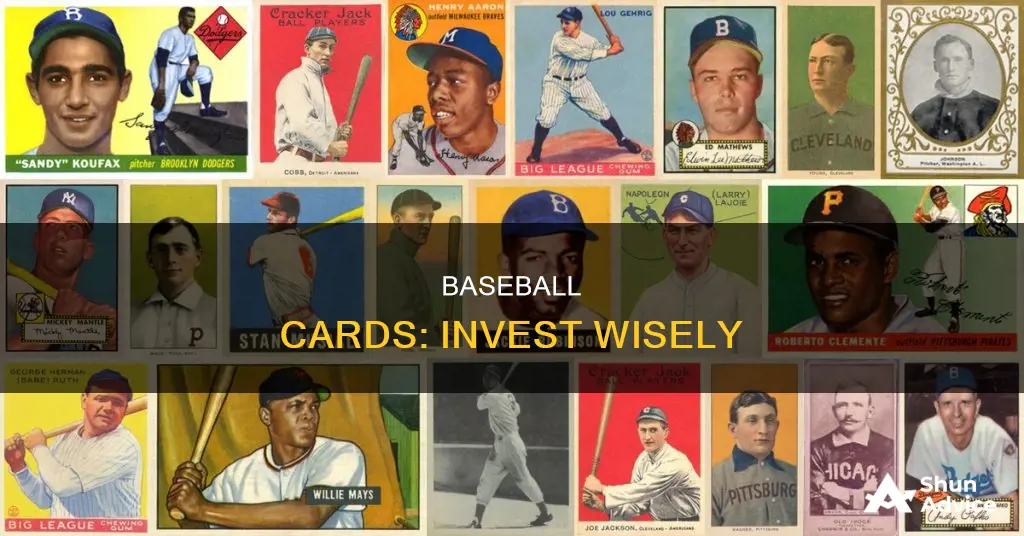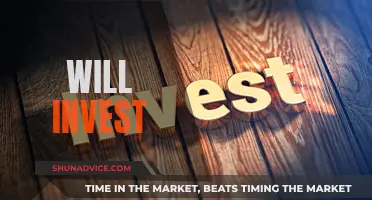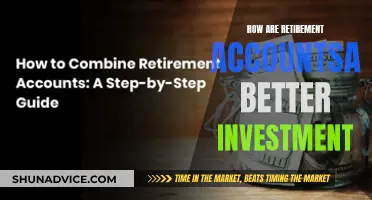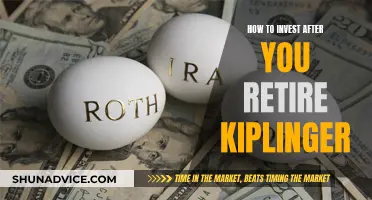
Investing in baseball cards can be a lucrative endeavour, but it requires careful consideration and knowledge of the market. The baseball card market is influenced by factors such as supply and demand, the player's performance, and the card's condition, scarcity, and age. Here are some key insights and strategies to help you make informed decisions when investing in baseball cards:
- Demand and Scarcity: The demand for baseball cards is increasing, while the supply of vintage cards is limited, driving up their value.
- Rookie Cards: Rookie cards are highly sought-after, especially for players with superstar potential. However, it's important to do your research and not follow the flavour of the month.
- Card Condition and Grading: The condition and grading of a card are crucial factors in determining its value. Top-grade cards are a must for investors.
- Vintage Cards: Investing in vintage cards from players like Jackie Robinson, Willie Mays, or Hank Aaron is generally considered safer as their value is historic and less prone to fluctuations due to injury or a player's performance.
- Diversification: Diversifying your collection across different sports, players, series, and card types is essential to manage risk.
- Long-Term vs. Short-Term: Decide if you're investing for the long term or looking for shorter-term profits. Card flipping, for example, involves buying and selling cards within a short timeframe.
- Autographed Cards: Autographed cards, especially from highly sought-after players, can add significant value to your collection.
- Research and Knowledge: Take the time to learn about the hobby, the players, and the market trends. Talk to knowledgeable collectors and dealers to get insights on potential investment opportunities.
| Characteristics | Values |
|---|---|
| Condition | The better the condition, the more valuable the card |
| Scarcity | Cards with fewer copies are more valuable |
| Age | Vintage cards are a safer investment |
| Player | Cards of famous players are more valuable |
| Rookie cards | Cards of players who are new to the major leagues are valuable |
| Demand | Demand outweighs all other considerations |
| Topps cards | Topps is a popular card manufacturer |
| Bowman cards | Bowman is another popular card manufacturer |
| PSA grading | PSA 10 is the highest grade |
What You'll Learn

Diversify your collection
Diversifying your baseball card collection is a must. If you were to invest only in one series of baseball cards, and they fall out of favour, that would be akin to putting all your eggs in one basket.
There are many ways to diversify your collection. Firstly, you could collect cards from various sports, not just baseball. This will help to spread your risk, as your collection will not be dependent on the performance of one sport.
Secondly, you could collect cards from different players. This is a good strategy if you are investing in rookie cards, as you cannot know for sure which players will become superstars.
Thirdly, you could collect cards from different series and generations. This will help to protect your collection from changes in the market, as some series or generations may fall out of favour.
Finally, you could collect different types of cards, such as rookie cards, cards with printing errors, or autographed cards. This will give your collection more variety and potentially increase its value.
By diversifying your collection, you can reduce the risk of losing money and increase the chances of making a profit. It is important to remember that investing in baseball cards can be risky, so you should only invest money that you are willing to lose.
College: Investing in a Brighter Future
You may want to see also

Buy vintage cards
Overview
The value of vintage baseball cards has been steadily increasing over time, making them a good investment option. However, it's important to remember that investing in vintage cards doesn't usually bring quick profits. Instead, they provide a steady increase in value over an extended period.
Tips for Investing in Vintage Baseball Cards
- Determine your budget: Before investing, decide on a budget that you're comfortable with. This will help you choose which cards are within your price range.
- Understand grading: Familiarize yourself with the grading standards used by companies like PSA, SGC, and Beckett. Graded cards are the best way to assess value and are generally more liquid.
- Focus on rookie cards: Most investing revolves around a player's rookie cards. Do your research to identify the year and brand of a Hall of Famer's rookie card.
- Research pricing: Understand the market value of cards by using resources like eBay's "sold" search function and VintageCardPrices.com. This will help you make informed decisions about which cards to invest in.
- Consider population reports: Utilize population reports from companies like PSA to compare the rarity and demand for different cards. This can help you identify cards with low populations in high grades, which generally appreciate more quickly.
- Buy the highest grade you can afford: High-grade cards, especially those with low populations, tend to appreciate faster. It's better to own a smaller number of cards in high grades than a large number of lower-grade cards.
- Consider eye appeal: While grading standards are important, don't overlook the visual appeal of a card. Sometimes, a lower-grade card can have better centering, colour, gloss, or other features that make it more attractive.
- Look beyond rookie cards: Don't discount a player's second-year cards or cards from later in their career. These can be more affordable alternatives to rookie cards while still holding long-term value.
- Think long-term: Vintage baseball cards typically appreciate at a slow rate, so don't expect to double your money overnight. Focus on cards that will likely increase in value over time.
- Invest in popular players and sets: Opt for cards featuring popular players from well-known sets. For example, cards like T206 Cobb, 1933 Goudey Ruth, and Mickey Mantle cards are always in high demand.
- Diversify your portfolio: While vintage cards can be a great investment, don't put all your eggs in one basket. Consider allocating a portion of your investment funds (e.g., 5%-10%) to vintage cards as part of a diversified portfolio.
Example of Vintage Card Value Appreciation
Take the 1957 Topps Hank Aaron #20 card as an example. In 2007, a PSA 7 version of this card could be purchased for around $239. By 2019, the same card was valued at $800, and today, it's worth well over $1,000. This illustrates the steady increase in value that vintage cards can provide over time.
Stock Market: Invest Now or Later?
You may want to see also

Invest in Topps rookie cards
Topps baseball cards have been around for decades, and their rookie cards are highly sought-after by collectors. Here are some tips for investing in Topps rookie cards:
Understanding the Market
The baseball card market is complex and ever-changing, so it's important to do your research before investing. Learn about the hobby, follow market trends, and seek advice from knowledgeable collectors and dealers.
Demand and Scarcity
The value of baseball cards, like other collectibles, is primarily driven by market demand. Rookie cards are particularly valuable due to their limited supply and high collector demand. The younger the player depicted on the card, the higher the potential for long-term value.
Grading and Condition
The condition and grade of a card are crucial factors in determining its value. Aim for cards in near-mint or better condition, especially for older cards. Properly grading cards is essential, as a trained eye can spot subtle differences in condition that significantly impact their worth.
Topps vs. Bowman Cards
While Topps rookie cards are traditional and widely collected, Bowman 1st cards have gained more attention in recent years. Bowman cards feature players before they appear on Topps cards, making them feel fresher and more exciting to collectors.
Vintage Cards
Vintage baseball cards from the 1930s to the 1980s are generally considered a good investment due to their limited supply and increasing collector demand. Pre-1980 cards in top-grade condition are especially valuable.
Diversification
Diversifying your collection is a prudent strategy. Invest in a mix of proven commodities (e.g., Hall of Famers) and speculative options (e.g., prospects and rookies). A common rule of thumb is an 80/20 split between Hall of Famers and prospects.
Specific Topps Rookie Cards to Consider
- Wander Franco (2021 Bowman's Best)
- Jarren Duran (2022 Topps Series 1)
- Reid Detmers (2022 Topps Series 1)
- Elly De La Cruz (2024 Topps Series 1)
- Jasson Dominguez (2024 Topps Series 1)
- Evan Carter (2024 Topps Series 1)
- Colton Cowser (2024 Topps Series 1)
- Christian Encarnacion-Strand (2024 Topps Series 1)
Stash Investing: Millions of Users
You may want to see also

Buy Minor League cards
Minor League cards can be a good investment, but it's important to note that this area of the baseball card market is more complex than simply investing in Major League cards of established stars. The value of Minor League cards is influenced by a variety of factors, and there are some additional considerations to keep in mind.
Firstly, it's worth noting that Minor League cards, particularly those produced before 1985, tend to be scarcer than their Major League counterparts. This is because fewer cards were printed for Minor League players during that time period. As a result, older Minor League cards that feature future superstars can hold their value or even increase in value over time. For example, the 1981 Pawtucket set with Wade Boggs is likely to have retained its value.
However, investing in Minor League cards requires a good understanding of the game and the players. It's crucial to identify players with the potential to become superstars. This can be challenging, as it involves predicting a player's future performance and impact in the Major Leagues. One strategy is to focus on players who are flying under the radar or are temporarily overshadowed by other prospects. By the time a player becomes a well-known star, their card values may have already skyrocketed.
Additionally, it's important to pay attention to the condition and grade of the cards. Top-grade cards are a must for investors, as they tend to increase in value over time. Make sure to properly educate yourself on how to grade cards, as even minor differences in condition can have a significant impact on the card's value.
When investing in Minor League cards, it's also worth considering the broader context of the Minor League system. In recent years, there have been plans to eliminate a significant number of Minor League teams, which could impact the availability of new cards and the overall demand for Minor League collectibles. Keep an eye on industry news and be mindful of potential shifts in the market.
In conclusion, investing in Minor League baseball cards can be lucrative, but it requires a good understanding of the sport, an eye for spotting future talent, and a focus on card condition and grading. Remember that this area of investing comes with its own unique challenges and considerations.
Investing Strategies: Where to Place Your Money in a Downturn
You may want to see also

Look for cards with printing errors
Printing errors are a great way to find valuable cards. These errors are often rare and can be worth a lot of money. Printing errors can include anything from cards with the wrong photo, name, or birth date. Here are some examples of valuable baseball cards with printing errors:
- 1990 Topps Frank Thomas NNOF: This card is missing the player's name on the front, making it a valuable error card. A BGS 8 copy of this card sold for over $9,000 in May 2023, while a regular Frank Thomas base rookie card in perfect condition sells for around $60-$80.
- 1989 Fleer Billy Ripken "FFACE:" This card became famous due to an error where a profanity was written on the knob of the bat. Fleer issued corrected versions, but the original error card is valuable, with a PSA 10 selling for around $400-$500.
- 1969 Mickey Mantle Name in White: This card features an error where Mantle's name is printed in white instead of yellow. A PSA 5 "white letter" error sold for $2,500 in May 2023, while the correct version in PSA 5 sells for around $300-$500.
- 1987 Donruss Opening Day Barry Bonds: This card features the wrong photo, with Bonds' teammate Johnny Ray on the card instead. A BGS 9.5 sold for over $2,200 in October 2022, while the correct version in BGS 9.5 sold for $84 in January 2023.
- 1989 Upper Deck Dale Murphy Reverse Negative: This card features Murphy's photo printed in reverse, which is a rare error. A PSA 10 of this card sold for $730 in April 2023, with 725 total reverse negatives graded and 118 receiving a grade of 10.
Printing errors can also include miscut cards, where the card is not cut properly during the production process. However, it's important to note that not all miscut cards are worth more, as the demand for these cards may not be high.
Markets in Turmoil: Investments Down Across the Board
You may want to see also
Frequently asked questions
Diversify your collection by collecting cards from various sports, players, series, generations, and types. You can also try card flipping, which is buying a card with the intent of selling it at a profit in a short time. You could also buy cards you enjoy, of players who you like, or those that you think could increase in value in the future.
Vintage cards are the safest bet. Players like Jackie Robinson, Willie Mays, and Hank Aaron no longer have the risk of getting injured or having a down season, so their value is historic and doesn't fluctuate much. You could also invest in Topps rookie cards, which are a player's first Major League card.
Like all other collectibles, a baseball card’s value is dependent on market demand. A card’s condition, its scarcity, and in some cases, its age are important factors. Rookie cards are also valuable because collector demand has caused their prices to rise significantly.







